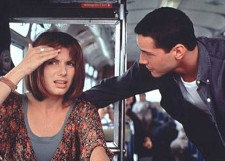 Let’s get one thing straight: DC Comics does NOT suck. Superman and Batman were starting to look a bit burried under a landslide of Marvel movies. Marvel Comics built its own film studio and every, single Marvel character (even the really stupid ones) had to have his or her own movie. People were starting to say that DC couldn’t hack it, or that they had Batman, but that was their only decent francise. The truth is, DC has been very much alive during Marvel’s decade of dominance at the box office. It simply stayed in the realm of animation. A TV series called Justice League ran from 2001 to 2006, and spawned a large number of hour-long movies. (By the way, Kevin Conroy’s Batman from the animated series is still going strong.) But finally, DC has had the courage to step into the
Let’s get one thing straight: DC Comics does NOT suck. Superman and Batman were starting to look a bit burried under a landslide of Marvel movies. Marvel Comics built its own film studio and every, single Marvel character (even the really stupid ones) had to have his or her own movie. People were starting to say that DC couldn’t hack it, or that they had Batman, but that was their only decent francise. The truth is, DC has been very much alive during Marvel’s decade of dominance at the box office. It simply stayed in the realm of animation. A TV series called Justice League ran from 2001 to 2006, and spawned a large number of hour-long movies. (By the way, Kevin Conroy’s Batman from the animated series is still going strong.) But finally, DC has had the courage to step into the
big leagues with one of their less-recognized characters.
The Green Lantern is a much maligned superhero. People are quick to dismiss him because *snort!* “His weakness is yellow! How pathetic is that?” The thing you have to remember is that Green Lantern mythology is not meant to be taken at all literally. While many superhero stories fit pretty well into the science fiction category, Green Lantern is thoroughly fantasy; it seeks to make sense only in a metaphorical or symbolic way. And while the events on screen are impossible to take seriously, they still capture the universal human experience. A good example is the GL-centrered espisode of Justice League “Despero,†which takes place on another planet, but spells out the very earthly themes of seduction by power and the spirit to resist oppression. It’s the same with this movie. Green
is the color of will. Yellow is the color of fear. As Corps General Sinestro (Mark Strong) explains, “it is fear that stops will; stops you from acting.” That’s why yellow can stop green.
This film does a really good job of bringing Hal Jordan (Ryan Reynolds) and company to the big screen. The origin story is, of course, the necessary evil of every super hero film, and like many films this one has been criticized for being light on action. There’s some truth to that, but, to be honest, I really didn’t notice. Writer Greg Berlanti draws the audience into the story so well, and the cast (especially Reynolds) fills out their roles so well, that mind-blowing action isn’t really necessary.
One interesting development: for obvious reasons, a few years ago, DC began to think that GL creating tanks and tigers from his ring to chase the bad guys was a bit … cartoonish, and so Justice League
limited his power to creating energy shields, lasers and the like. In Green Lantern, the cartoonishness is back, with Hal whipping out gatling guns and roadsters at every turn. But the biggest surprise of all is probably that they make it work pretty well. The story centers around the Corps’ battle with an entity known as Parallax (oddly named after Hal’s eventual super-villain identity from the comics) and Hal’s struggle to be accepted by the Corps. It also has a few goodies, such as a nod to Sinestro’s inevitable slide into super-villiandom, and one absolutely priceless moment that backhands the secret identity complexes of superheroes everywhere.
So how does Green Lantern stack up? It doesn’t have the gritty reality of The Dark Knight, the heart-warming inspiration of Iron Man, or the powerful iconography of Superman Returns. But it’s still a solid adaptation of an under-rated franchise that’s worth checking out.  Incidently, so is the animated Green Lantern: First Flight. Green Lantern is clearly better than:
Electra
The Fantastic Four
The Fantastic Four 2
The Punisher
Spiderman 2
Hulk.
And probably at least as good as:
Ghostrider
Daredevil
Wolverine
So stop knocking it. If nothing else, the color green has been proven to reduce stress, and this movie has it in spades.
[Rating:3/5]




















